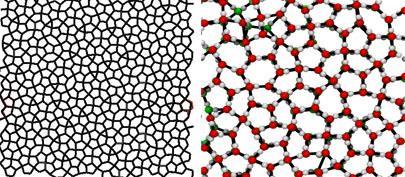Water can adopt a 'forbidden' quasicrystalline state with twelve-fold symmetry, say US researchers
With at least fifteen different crystal forms, two different disordered solid phases (glasses), and perhaps two different liquid states, water is a prodigious shape-shifter. But Valeria Molinero and colleagues at the University of Utah, US now claim that water has still more tricks up its sleeve. They say that, when water is confined between two flat plates just 8.5 Angstroms apart - room enough for just two molecular layers - it can adopt a quasicrystalline state which appears to have a ’forbidden’ twelve-fold symmetry.
Although there have been speculations that water might adopt such a solid form, there has previously been no firm evidence that it might exist. What’s more, all earlier quasicrystals have been mixtures of two or more components, making this the first to be composed of just one. So far, however, it’s just a prediction based on computer simulations - the Utah group hasn’t observed quasicrystalline water experimentally.
Quasicrystals were first discovered in 1984 in an alloy of manganese and aluminium. Like crystals, they generate x-ray diffraction patterns with symmetrically arranged bright spots, but with symmetries - five-, ten- and twelve-fold - that can’t be produced by any regular, orderly packing of constituent particles. Instead, quasicrystals are not perfectly periodic: they contain local atomic arrangements with these forbidden symmetries, but which do not repeat exactly.

Water seems a good candidate for making an ice-like quasicrystal, because hydrogen bonding between the molecules favours the formation of pentagonal rings.
Molinero and colleagues simulated water between the two plates at pressures of up to 5000 atmospheres: the pressure promotes pentagonal rings rather than the hexagonal rings of regular ice, because they are more compact. The researchers found one crystal phase made up of pentagons linked with four-fold symmetry, and another phase composed of both pentagons and hexagons, with twelvefold quasi-symmetry. Hideki Tanaka of Okayama University in Japan, a specialist in simulations of water and ice, says that the findings are ’of significant interest’, although he adds that he’s not convinced it will prove possible to observe it experimentally
Molinero admits that the conditions of the simulations are hard to create experimentally, but adds the researchers have also found that the quasicrystal state can be stabilised without applying pressure, by tuning the strength of the water-surface interaction. So it might conceivably be made by depositing a thin film of water onto a single flat surface. ’Our holy grail is vapour deposition of the quasicrystal,’ she says. ’But I expect it will take us a while, or a stroke of good luck, to be able to predict the surfaces and temperatures needed for that.’
Philip Ball
References
J. Chem. Phys., 133, 154516 (DOI:10.1063/1.3499323)






No comments yet